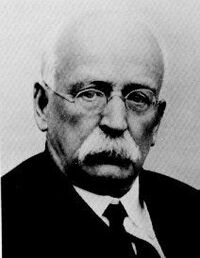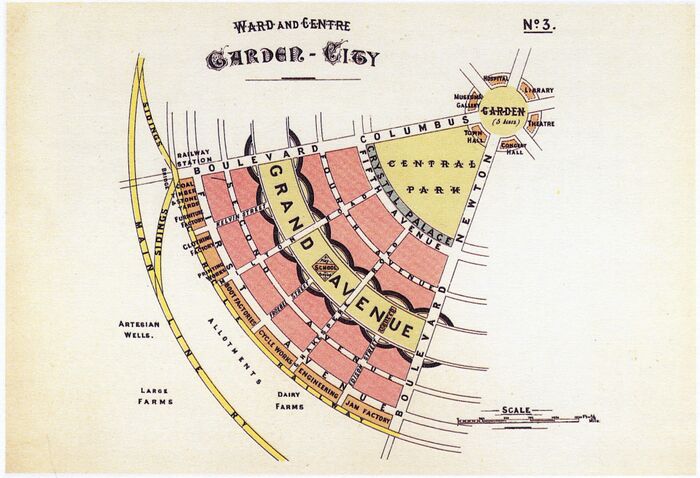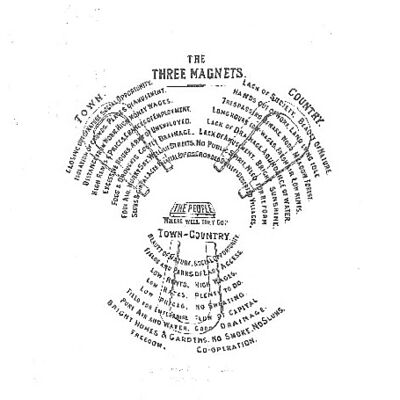Sir Ebenezer Howard (1850-1928), Visionary & City Planner
Sir Ebenezer Howard was an English city planner and designer of the two English "Garden Cities", as well as the founder of the Garden City Movement.[c] He lived a brief time in Nebraska in 1872.[1] He was an influential figure in the realm of urban planning around the turn of the century, with a focus on marrying town and country.[1][14][c]
Howard was born in London, England on January 29,1850.[10][11] After growing up in boarding schools, he began working in business at age 15, soon teaching himself shorthand and becoming a shorthand clerk in London.[2]
Around 1872, Ebenezer Howard left England with two friends to homestead in Nebraska, intending to be a farmer.[2][5][9] He may have been inspired by his uncle, who was a farmer in England.[9] Howard and his friends joined a small party of Irish Canadians in Des Moines on their way to a location outside of Farwell, Nebraska.[5][7] His 160 acre homestead happened to be in Howard County, Nebraska.[5][a] The winter of 1873 was a difficult one in Howard County, and Ebenezer Howard quickly determined that he did not want to be a farmer. However, several sources imply that emigrating to Nebraska in his youth helped establish many of his lifelong beliefs that progress could involve incorporating Nebraska-like open spaces and agriculture into English cities.[4][7][15][17][18] 19th century Nebraskan landscape architect Lawrence Enersen said, "this man whose ideas changed the course of town planning around the world, got the kernel of his idea from his brief but impressive stay in Nebraska in 1872."[17] In the spring, only a few months after arriving, Howard left Nebraska for Chicago to find work as a stenographer.[2][6][7] Ebenezer Howard returned to England in 1876, where he resumed work as a shorthand clerk, this time for the official shorthand writers to the House of Parliament.[2]
In 1898, Howard published his book, To-morrow: A Peaceful Path to Real Reform (later republished as Garden Cities of To-morrow), which introduced his approach to a new kind of urban planning and initiated the Garden City Movement.[2] With a goal to build his garden city in England, he needed to finances to buy the land. The next year, Howard founded the Town and Country Planning Association, referred to as the TCPA, so that he could gather the money he needed.[9][12][14] The association “represented a fusion of ideas about social justice, beauty in design, health and wellbeing and economic efficiency.” [12][c] In 1899, the TCPA created First Garden City, Ltd. to build the garden city of Letchworth in 1903.[14][d] In 1919, Howard bought the land to build Welwyn Garden City.[14] Dozens of other English and some U.S. cities have been built using the garden-city design, as well as other cities around the world, such as the 1980 garden city of Almere, Netherlands.[9][15][17][e]
"Town and country must be married, and out of this joyous union will spring a new hope, a new life, a new civilization." (Ebenezer Howard, 1898)
Howard married Eliza Ann Bills, and they had three daughters and a son.[11][16] After Eliza's death, he remarried in 1908.[16] Ebenezer Howard died on May 1, 1928 in Letchworth Garden City, England.[10][11]
This page is a contribution to the publication, Place Makers of Nebraska: The Architects. See the format and contents page for more information on the compilation and page organization.
Contents
[hide]Educational & Professional Associations
1854-1865: boarding school, Sudbury, Suffolk, and Cheshunt, and Ipswich, England.[2]
ca. 1865: business employee, stockbroker’s office, London, England.[2]
ca. 1865-ca. 1868: business employee, city merchant’s counting-house, London, England.[2]
ca. 1868-ca. 1869: shorthand clerk, solicitor’s office, London, England.[2]
ca. 1869-ca. 1870: private secretary for Dr. Joseph Parker at Poultry Chapel, London, England.[2][16]
1870-1872: shorthand clerk, solicitor’s office, London, England.[2]
1872-1873: farmer, rural Farwell, Howard County, Nebraska.[1][2][6][7][a]
1873-ca. 1876: court stenographer, Chicago, Illinois.[2][5]
1876-ca. 1878: shorthand clerk, Messrs. Gurney & Sons, official shorthand writers to the House of Parliament, London, England.[2][16]
ca. 1878-ca. 1898: partner and shorthand clerk, Ebenezer Howard and William Treadwell, London, England.[2]
ca. 1879-ca. 1899: member and speaker, Zetetical Society, London, England.[2]
1899-1928: founder and member, Garden Cities Association (later the Town & Country Planning Association), London, England.[9][12]
1927-1928: honorary British knight, London, England.[13]
City Plans Influenced by Howard's Garden Cities Vision
Letchworth Garden City (1903), Hertfordshire, England.[14][d]
Welwyn Garden City (1919-1920), Hertfordshire, England.[14]
Lincoln Air Force Base 600-unit Housing Project (1959), Lincoln, Nebraska.[17][f]
Almere (1976-1984), Almere, Netherlands.[9][b][e]
Writings, Publications, and Etc.
Ebenezer Howard, To-morrow: A Peaceful Path to Real Reform (later republished as Garden Cities of To-morrow) (London: 1898).
Honors & Awards
1924: appointed to O.B.E., Officer to the Order of the British Empire.[16]
1927: knighted by Britain, earning the title Sir Edward Howard.[13][16]
n.d.: honorary associate of the Royal Institute of British Architects.[16]
n.d.: honorary member of the Leningrad Architects' Society.[16]
Notes
a. Howard likely arrived in Nebraska in mid-to-late 1872 and left just months later in the spring of 1873. According to [the associated reference], Howard’s homestead “originally was the 160 acres in the SW quarter of section 2, which was along Highway 11, east of Farwell. The NW quarter of that section apparently was homesteaded by John Jordan, one of the friends with whom Howard said he traveled with to Nebraska.” That section may have been transferred to Howard later. [7]
b. Almere, Netherlands was built long after Howard initiated the garden city movement, as well as the garden cities built in England. However, the city was heavily inspired by Howard's plans and recognizes him today for the inspiration.[9]
c. Source [14] describes his garden-city plans; "Ideally his garden city would accommodate 32,000 people on a site of 6,000 acres (2,400 ha), planned on a concentric pattern with open spaces, public parks and six radial boulevards, 120 ft (37 m) wide, extending from the centre. The garden city would be self-sufficient and when it reached full population, another garden city would be developed nearby. Howard envisaged a cluster of several garden cities as satellites of a central city of 50,000 people, linked by road and rail."[14]
d. The architects hired to plan Letchworth Garden-City ignored Howard's symmetric design, and replaced it with a more "organic" design.[14]
e. In the garden city of Almere, Netherlands, a horticultural exposition called Floriade 2022 is held in the year 2022, boasting the theme: "Growing Green Cities". The city publicly owes its inspiration to Ebenezer Howard.[9][19][20]
f. The architects for the Lincoln Air Force Base were Clark & Enersen, Architects, Nebraskan architects who were inspired by Ebenezer Howard's life and his garden city movement after researching him and his experience in Nebraska. They designed the air park with plenty of open space "country" in the center of the housing area, and surrounding it.[17]
Acknowledgements
We would like to thank Randy Lukasiewicz for providing us with several sources used on this page.
References
1. Randy “Bat Man” Lukasiewicz, “The Three Magnets” from Ebenezer Howard, To-morrow: A Peaceful Path to Real Reform, in letter, n.d. In NSHS file
2 “Social Servants-L.” Social Service Monthly No. 63 (July, 1909), pg. 145-147.
3. Ebenezer Howard, To-morrow: A Peaceful Path to Real Reform (later republished as Garden Cities of To-morrow) (London: Faber and Faber, [1946]):50-57, 138- 147. Accessed January 16, 2020 via http://urbanplanning.library.cornell.edu/DOCS/howard.htm
4. “An Appreciation” The Welwyn News (Welwyn, England: 1927)
5. “Experiences in Nebraska” Biographical Note (ref. D/EHo F17), 1872. Hertfordshire Archives and Local Studies. Via email from Kathryn Thompson, Hertfordshire County Record Office, December 8, 1993.
6. Dr. Kathryn Thompson to Randy Lukasiewicz, letter correspondence, Hertfordshire County Record Office, December 8, 1993.
7. Gordon Scholz to Randy Lukasiewicz, “Ebenezer Howard,” email correspondence, June 27, 2000.
8. “Experiences as a Shorthand Writer in the US, 1872” Hertfordshire Archives and Local Studies. Via email from Kathryn Thompson, Hertfordshire County Record Office, December 8, 1993.
9. Linda Graanoogst, “Speech for business women: Malmö & Växjö” (Sweden, June 14, 2013).
10. “Ebenezer Howard” FindAGrave.com Accessed January 28, 2020 via https://www.findagrave.com/memorial/194744131
11. “Ebenezer Howard, OBE” Geni.com Acccessed January 28, 2020 via https://www.geni.com/people/Sir-Ebenezer-Howard/6000000021623421750
12. “Our History” tcpa.org Accessed February 4, 2020 via https://www.tcpa.org.uk/our-history-1
13. “Sir Ebenezer Howard” Britannica.com Accessed February 4, 2020 via https://www.britannica.com/biography/Ebenezer-Howard
14. "The Garden City Movement" Geni.com Accessed February 6, 2020 via https://www.geni.com/projects/The-Garden-City-Movement/15255
15. F. J. Osborn, "Sir Ebenezer Howard: The Evolution of His Ideas," The Town Planning Review, Vol. 21, No. 3 (Oct., 1950), pp. 221-235
16. "Death of Sir Ebenezer Howard: The Pioneer of the Garden City Movement" The Welwyn News (Welwyn, England: May 1928)
17. Carroll Thompson, "Idea Born in Nebraska" World-Herald Magazine (December 27, 1959)
18. "Work on Nebraska Farm led to 'Garden City' Planning Concept" Lincoln Sunday Journal & Star (October 25, 1959), 3B.
19. "About Floriade Expo 2022: ‘Growing Green Cities’" Floriade.com Accessed February 25, 2020 via https://floriade.com/en/about-us/
20. "The preparations for Floriade Expo 2022 in Almere will continue," FLORIADE NEWSLETTER Bureau of International Expositions (June 19, 2020). https://floriade.com/en/news/the-preparations-for-floriade-expo-2022-in-almere-will-continue/ Accessed July 22, 2020.
Page Citation
L. Allen & D. Murphy, “Sir Ebenezer Howard (1850-1928), Visionary & City Planner,” in David Murphy, Edward F. Zimmer, and Lynn Meyer, comps. Place Makers of Nebraska: The Architects. Lincoln: Nebraska State Historical Society, July 22, 2020. http://www.e-nebraskahistory.org/index.php?title=Place_Makers_of_Nebraska:_The_Architects Accessed, April 5, 2025.
Contact the Nebraska State Historic Preservation Office with questions or comments concerning this page, including any problems you may have with broken links (see, however, the Disclaimers link at the bottom of this page). Please provide the URL to this page with your inquiry.


